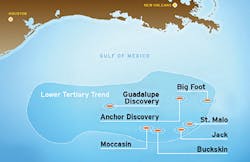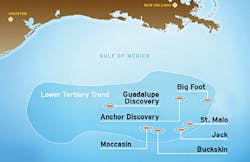Gulf E&P shows signs of resurgence
It’s no secret that E&P activities in the US Gulf of Mexico have been in the doldrums in recent years. Exploration and development work in the US deepwater Gulf has lagged since crude oil prices dropped in late 2014.
However, as costs finally settle at a bottom and operators set a new standard for operational efficiency, 2018 might be a turning point for the sector, according to a new study by Wood Mackenzie entitled “Deepwater GoM: 5 Things to Look for in 2018.”
William Turner, Wood Mackenzie’s Senior Research Analyst and lead author of the insight, said: “Although deepwater Gulf of Mexico has taken quite a beating over the last three years, the industry has clawed its way back to being competitive by significantly cutting costs, improving efficiencies and tightening up the supply chain. [This year] will be a forward-looking year for the sector as it lays the foundation for longer term resurgence in 2019 and beyond.”
According to the study, production of oil and gas in deepwater Gulf of Mexico is expected to reach an all-time record high in 2018 with 1,935 kboe/d forecasted (80% oil); surpassing the previous record in 2009 by nearly 10% and representing 13% growth year over year.
Total’s entry into the Anchor discovery further increases its footprint in deepwater Gulf of Mexico. Chevron remains the operator of the Anchor field. (Courtesy Chevron)
While 2018 promises to be a record-setting one for the region in terms of production, exploration activity is expected to remain flat. In fact, while more than half the discovered volumes globally are expected to be found in deepwater, the Gulf of Mexico will not follow the trend of high volume discoveries, says Wood Mackenzie. Instead, operators will continue to focus on conservative tieback prospects, which lead to higher success rates but inherently lower-volume, lower-impact finds.
“The current production growth in the Gulf of Mexico cannot be sustained with conventional deepwater fields,” Turner observed. “Increased investments in exploration and development, especially in ultra high-pressure, high-temperature technologies and projects, are crucial not only to maintaining the current pace of production but also in unlocking the next phase of significant volumes in the region.”
Turner continued: “Moreover, policy incentives specific to ultra high-pressure deepwater developments, which require longer lead times than conventional fields, will be crucial in making these volumes competitive against other more attractive reservoirs in Brazil and Mexico.”
Last year saw a string of positive policy developments for the sector, Wood Mackenzie says. The tax overhaul plan drastically increased the fiscal competitiveness of the deepwater Gulf of Mexico, relative to other offshore basins, the study found. Additionally, in August, the Bureau of Ocean Energy Management relaxed royalty rates to 12.5% for some shallow-water leases and the Bureau of Safety and Environmental Enforcement proposed a new system aimed at streamlining safety regulations.
“In the coming year, policy will play a key role in positioning the sector for a comeback in 2019,” said Turner. “We look forward to further discussions between the industry and policy makers this year, especially around fiscal terms for deepwater development.”
In the year ahead, the study finds that technology will continue to play an important role in improving efficiencies and safety as operators increasingly adopt advanced technologies to make deepwater more competitive. Technologies such as managed pressure drilling, which improve the competitiveness of ultra-high-pressure developments by increasing drilling efficiency and safety through automation, will see increased adoption and demand in 2018.
One area of particular interest is around seismic imaging which utilizes an actual application of big data. Operators are using supercomputers, big data and analytics to increase resolution and massively reduce image processing time; in some cases from over a year to a matter of weeks. The results enable smarter well placement and better well design for getting the most out of the reservoir, Wood Mackenzie says.
Several recent announcements by major and independent operators are providing evidence of this emerging resurgence. For example, development drilling operations have begun at the Buckskin project in the deepwater Gulf, according to LLOG Exploration Co.
Buckskin is located on Keathley Canyon blocks 785, 828, 829, 830, 871, and 872 in approximately 6,800 ft (2,073 m) of water. The initial phase consists of two development wells in Keathley Canyon 829 and a 6-mi (10-km) subsea tieback to the Lucius platform at Keathley Canyon 875.
The Seadrill drillshipWest Neptune is drilling the initial two wells to about 29,000 ft (8,839 m). This will be followed by installation of subsea facilities. First production is expected in mid-2019. According to LLOG’s president and CEO Scott Gutterman, Buckskin in the company’s first development in the Lower Tertiary trend.
Elsewhere, Stone Energy Corp. has reported drilling success at the deepwater Mt. Providence development well in Mississippi Canyon block 28. Stone generated the prospect and owns a 100% working interest in the well.
The Mt. Providence well (the MC 28 #4 well) encountered about 153 net ft (47 m) of high quality, primarily oil pay in one Miocene interval with no visible water level, which exceeded pre-drill expectations.
Completion operations on the well will begin in 2Q 2018 with first production expected in early 3Q 2018. The well is expected to have an initial production rate of 3,000 to 5,000 boe/d and will be tied back to the 100% Stone-owned Pompano platform through existing subsea infrastructure.
Separately, the Derbio well (the MC 72 #3 well) was expected to spud in late January. Derbio is a Stone-generated prospect and follows the Rampart Deep success announced in September 2017. If successful, the Rampart Deep/Derbio project could be a multi-well tieback to the Pompano platform, with first production expected by late 2019.
A third example of growing interest in the US Gulf could be seen in late January, when Total increased its presence in the deepwater GoM. It did so by reaching an agreement with Samson to acquire Samson Offshore Anchor, LLC, which holds a 12.5% interest in four blocks covering the deepwater Anchor discovery in the Gulf of Mexico.
The deal also includes a 12.5% interest in the nearby Green Canyon block 761, where Total already has a 25% interest.
Arnaud Breuillac, President Exploration & Production at Total, said: “The entry in the Anchor discovery further increases Total’s footprint in deepwater Gulf of Mexico. It follows our entry in seven exploration prospects located in the promising Wilcox (Central GoM) and Norphlet (Eastern GoM) plays thanks to an agreement signed with Chevron last September, and in the Jack field where the group will acquire a 25% interest as part of the Maersk Oil deal.”
Discovered in the Wilcox play in 2014, Anchor is about 225 km (140 mi) offshore Louisiana in more than 1,500 m (4,921 ft) of water.


